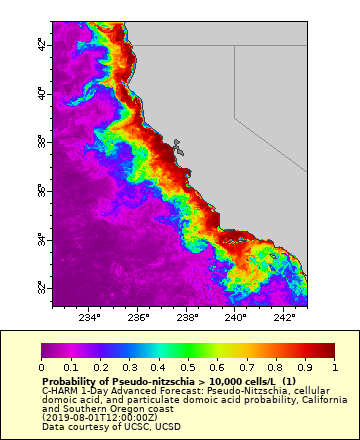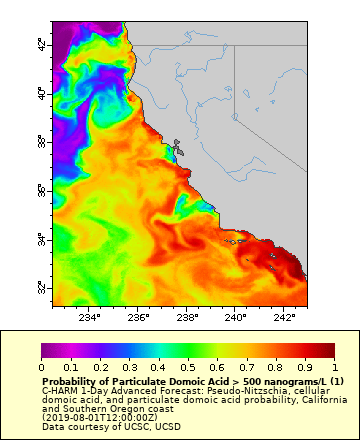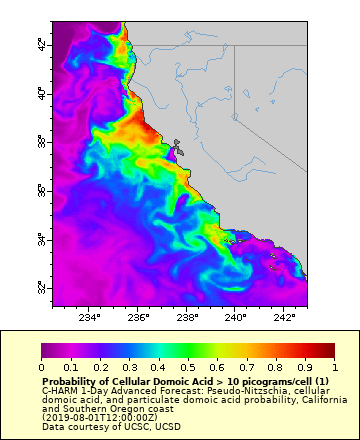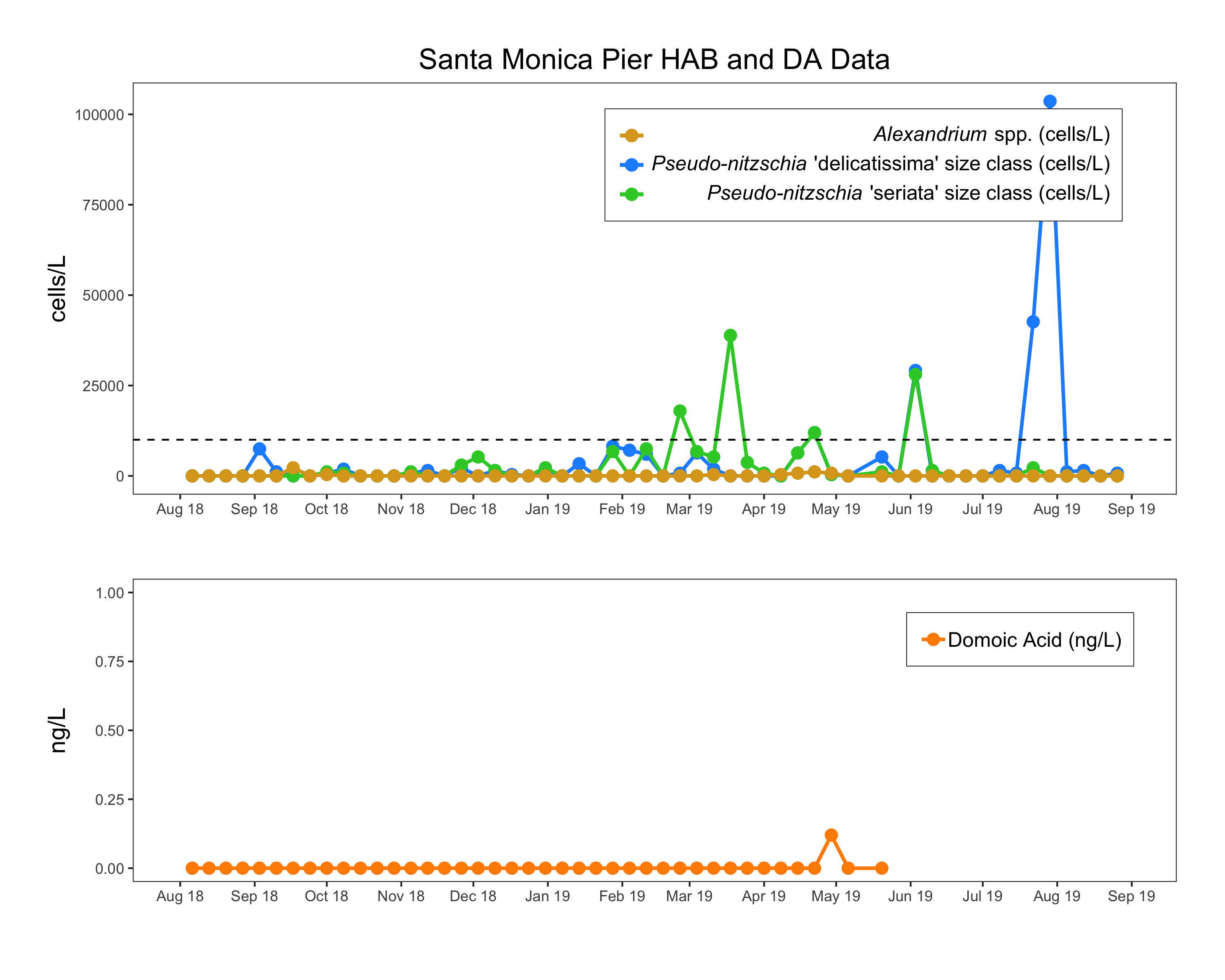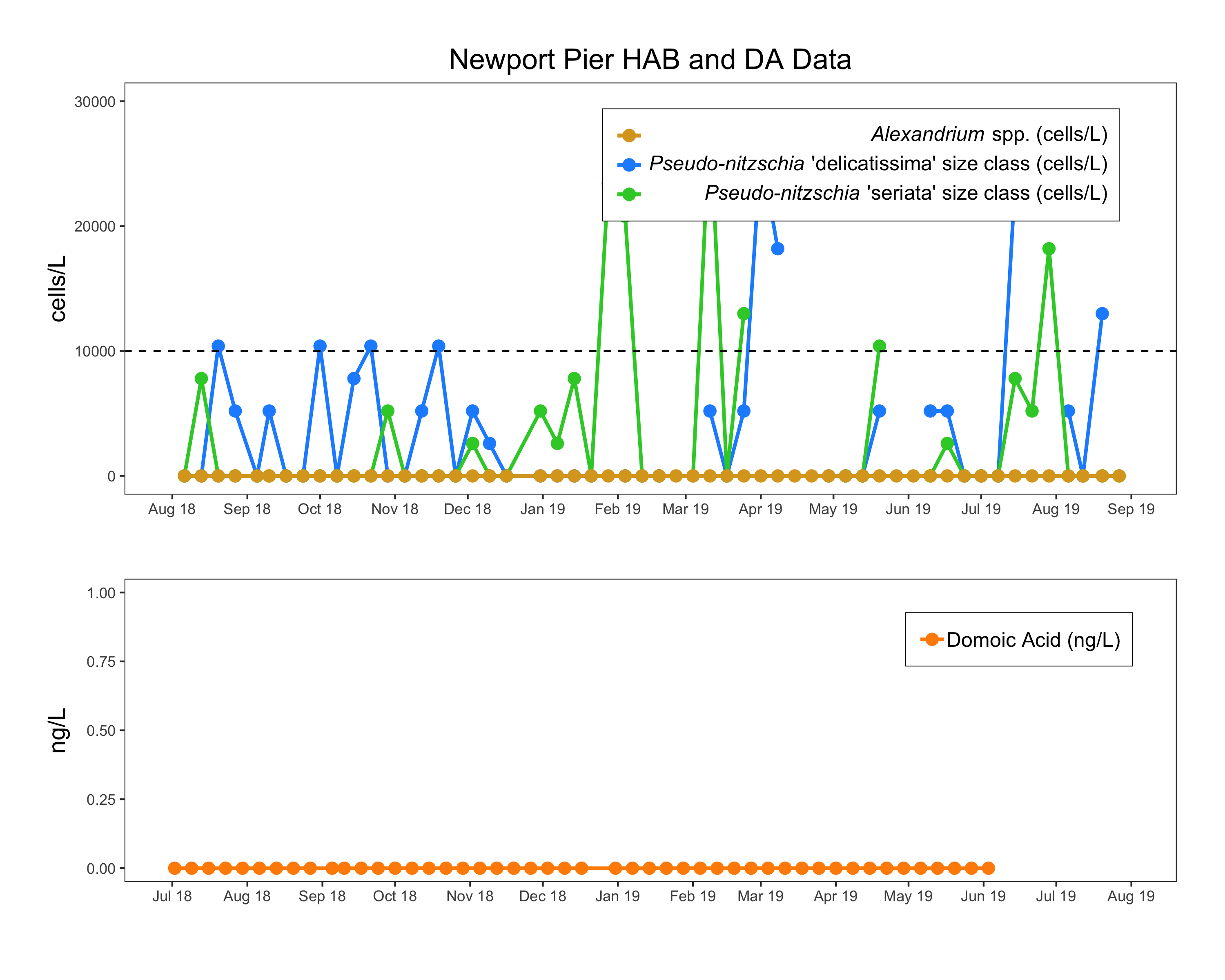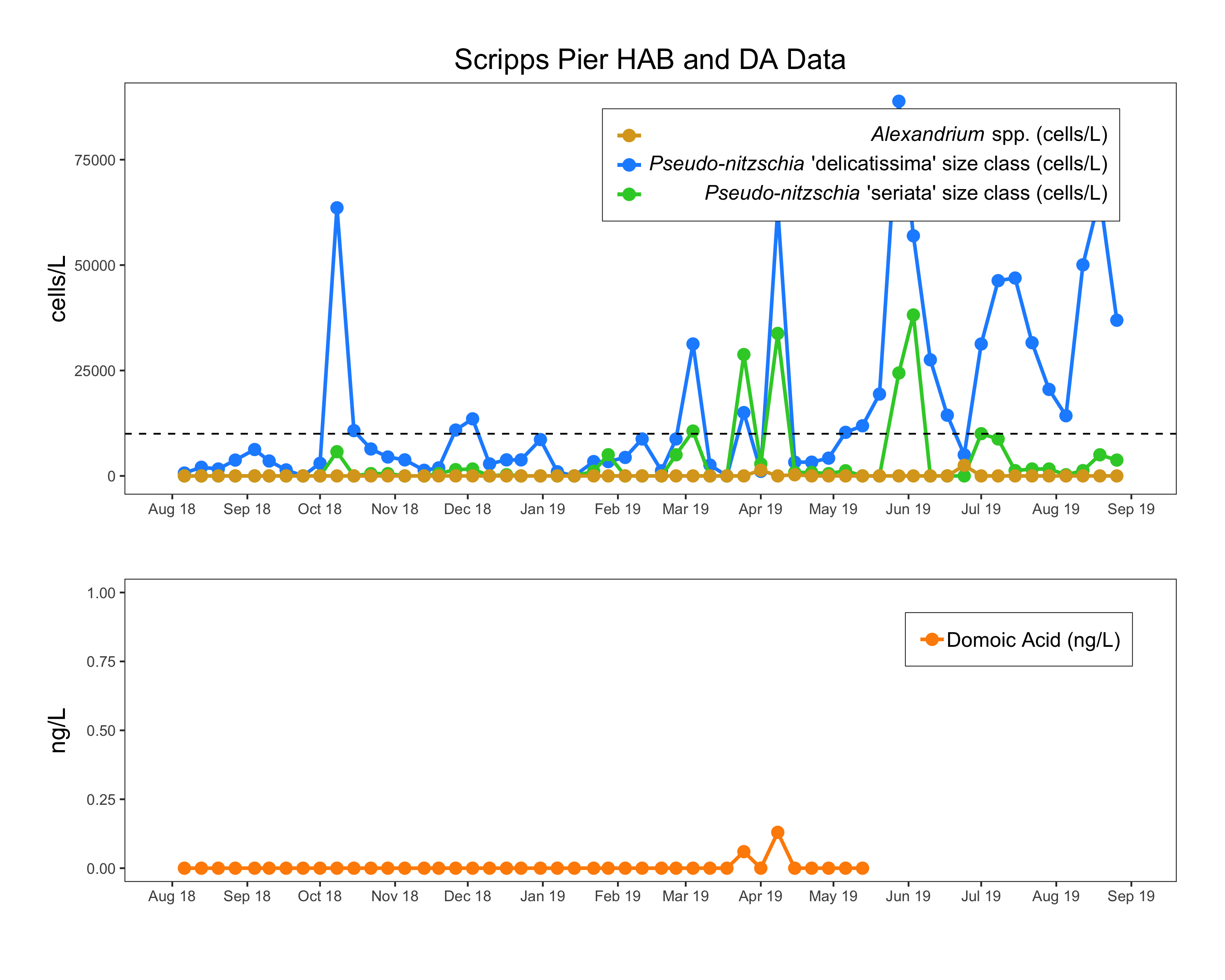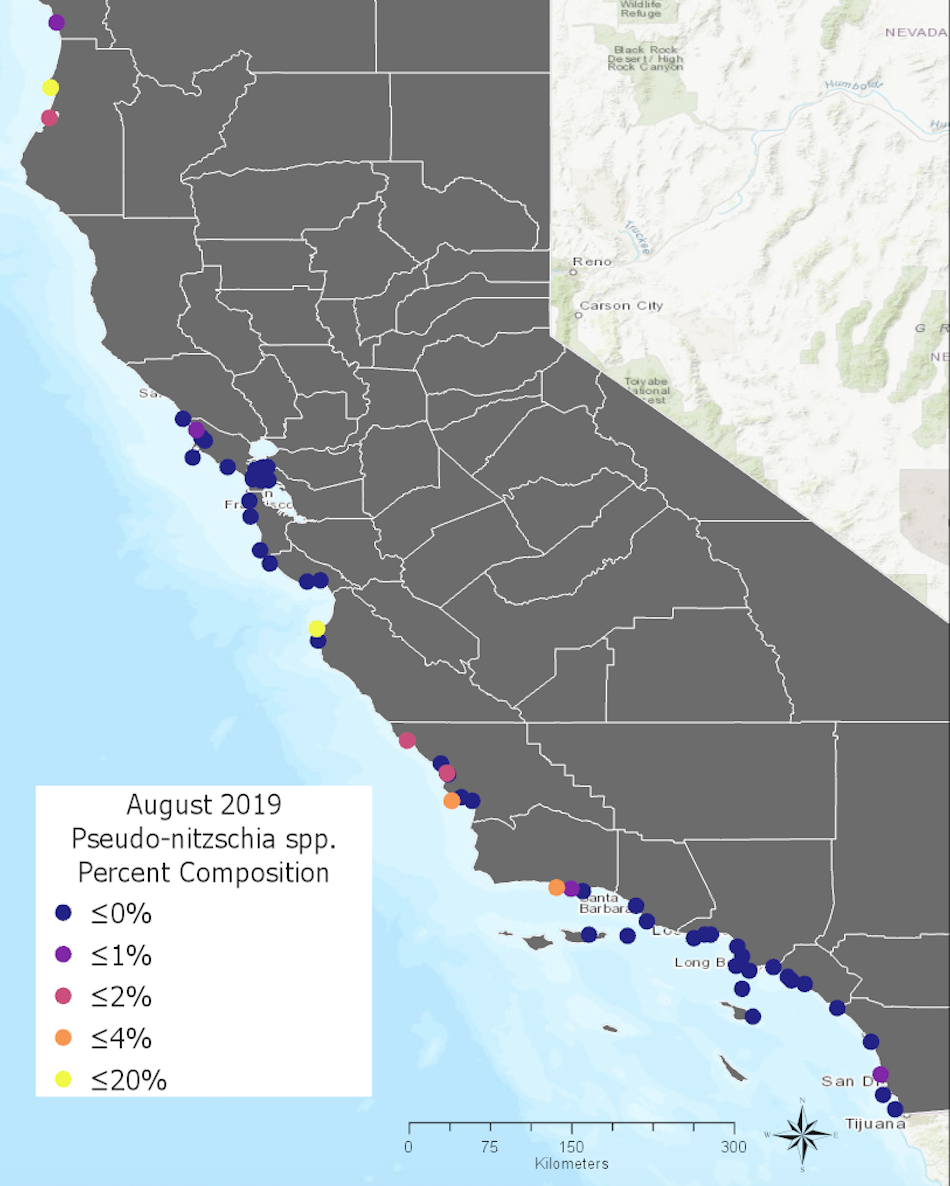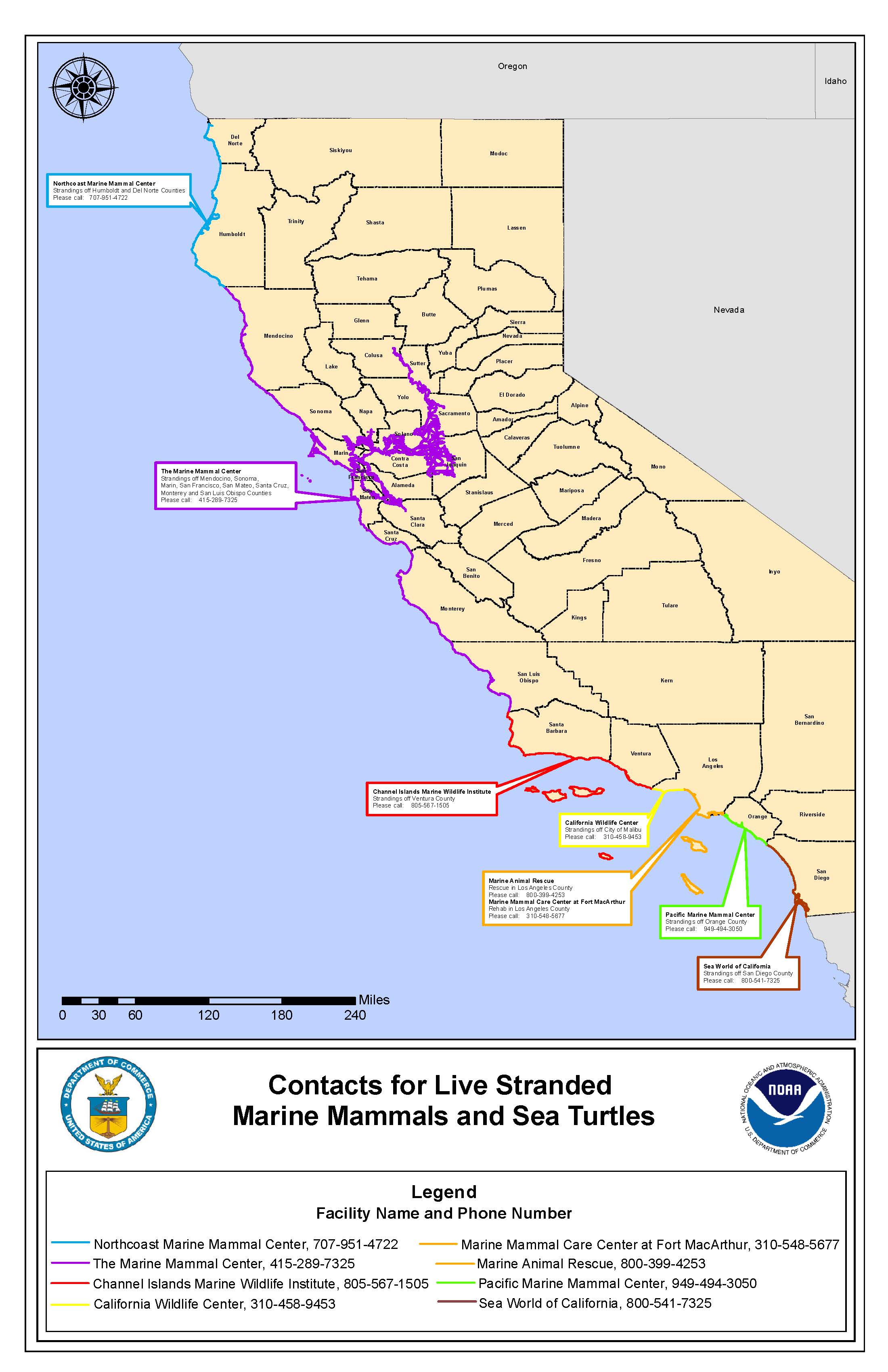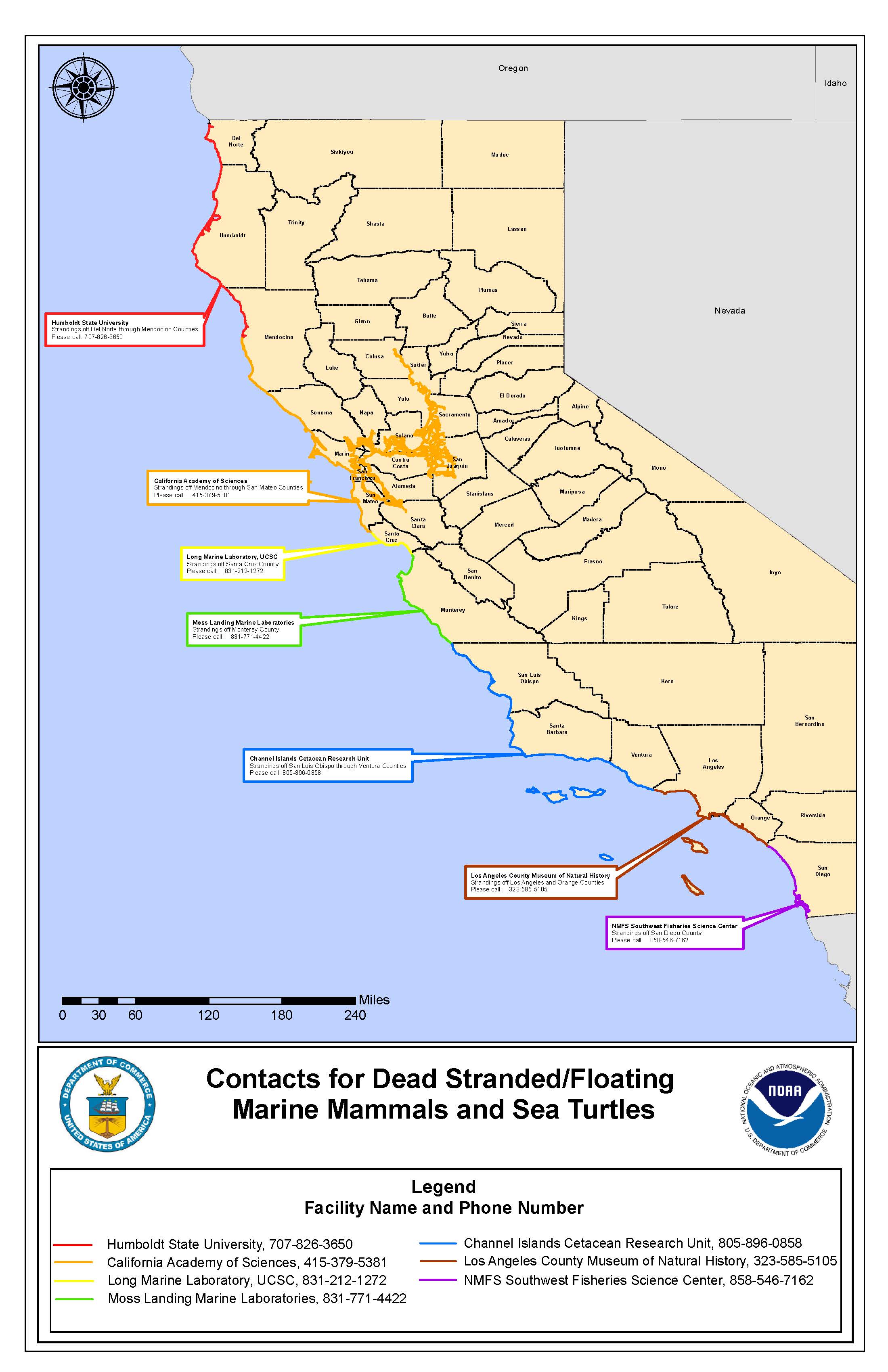Pseudo-nitzschia and Domoic Acid Predictions - C-HARM tells us where conditions are suitable for Pseudo-nitzschia spp. (all size classes) to grow well and where they might be more likely to produce Domoic acid (DA). In August, suitable habitat for Pseudo-nitzschia spp. was even more evenly spread throughout coastal California than in July, again with more patchy and slightly lower probabilities in the Southern California Bight and higher probabilities in offshore regions of Sonoma and Humboldt Counties as the month progressed. C-HARM predicted high but very patchy particulate DA (pDA) throughout most of the state, with the greatest probabilities of high DA along sections of the Humboldt and Sonoma coastlines, Half Moon Bay, Monterey Bay, and the Southern California Bight (including the Santa Barbara Channel and the transition region around Pt Conception). Notably, nearshore probabilities of pDA were low for the San Luis Obispo coast but high in offshore eddy-like patches, as was the case in July. C-HARM also indicates very high probabilities in cellular DA (cDA) distributed in patches. These patches intensify over the course of the month along the Humboldt coastline. In Sonoma and Monterey counties, cDA probabilities remained high throughout the month of August, extending offshore around 50-70 km and with a local minimum in probabilities just outside SF Bay. Patches of high cDA probability around Pt. Conception and San Miguel Island were not seen in the nearshore San Luis Obispo zone to the north, nor in the SB Channel proper, aside from some moderate blips throughout the month.
In comparison with the HABMAP measurements where we have the August data already available, bloom levels of both P. "seriata" and "delicatissima" size classes occurred at various times throughout the month in the Southern California Bight at Santa Monica Pier (Los Angeles Co.), Newport Beach Pier (Orange Co.) and Scripps Pier (San Diego Co.), but interestingly, not at Stearns Wharf in Santa Barbara. Blooms levels of the "seriata" (i.e., more toxigenic) size class were seen at Newport Beach Pier from late July to mid-August. Bloom levels of the "delicatissima" size class were also recorded at Cal Poly Pier (San Luis Obispo Co.) throughout most of August, but no Pseudo-nitzschia were seen at the Santa Cruz Wharf this month. DA data were not yet available for any of the HABMAP sites. Animal strandings potentially related to DA were concentrated in central California throughout August, consistent with the high C-HARM cDA and pDA probabilities in this region but inconsistent with the very low abundances of Pseudo-nitzschia spp. recorded at the Santa Cruz Wharf. Notably, northern fur seals are stranding in record numbers at The Marine Mammal Center (TMMC) in central CA, consistent with the bolus of high cDA probabilities in Sonoma County waters fairly far offshore. Tenaya Norris at TMMC says that "this species primarily breeds on islands in Alaska and Russia, and <2% of the population breeds on San Miguel and Farallon Islands. We don’t know too much about where these animals feed off of California, but they typically are at or just beyond the shelf break and are pretty shallow divers compared with sea lions (but they feed on similar prey items). Females nurse their pups June-November. Based on the stranding location of these animals, my guess would be they were exposed [to DA] off San Mateo-Sonoma Counties."
CDPH recorded their highest relative abundances of Pseudo-nitzschia spp. along the North Coast near Humboldt Co. and in the southern Monterey Bay. Moderate levels of Pseudo-nitzschia were measured along the San Luis Obispo coastline and near Santa Barbara. Unlike in July, Pseudo-nitzschia was no longer observed as a large proportion of the phytoplankton community in the Southern California Bight, although this is inconsistent with the high abundance values observed at Santa Monica Pier, Newport Beach Pier, and Scripps Pier via the HABMAP pier sampling program, highlighting the patchy nature of phytoplankton species composition from day to day and site to site.
Alexandrium - HABMAP records for Alexandrium spp. at pier sites. Only Cal Poly Pier (SLO Co.) and Santa Cruz Wharf showed any concerning rise in Alexandrium spp. abundance in August. This is somewhat consistent with CDPH sampling, which showed elevated relative abundance on the SLO coast and even higher composition rates outside San Francisco Bay, enough to lead to an early September alert from CDPH on the risk of paralytic shellfish (PSP) toxins in mussels from Sonoma Co. CDPH lifted a PSP advisory in SLO Co. on August 13th, just preceding the small peak in abundance of Alexandrium spp. recorded at Cal Poly Pier at the very end of August.
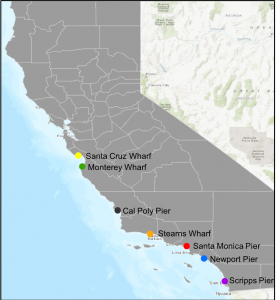
HABMAP Monitoring Sites
Note that data for some stations are not shown because they are not yet recorded in the public HABMAP archive.
Differentiating Pseudo-nitzschia species by light microscopy is difficult. For this reason, Pseudo-nitzschia "seriata" does not refer to an actual species but rather the larger size class of Pseudo-nitzschia, which is generally a more toxigenic group of species. Alternatively, Pseudo-nitzschia "delicatissima" refers to the smaller size class that is generally non-toxigenic. The dashed line on the plots demarcates the 10,000 cells/L "bloom" threshold designated here for Pseudo-nitzschia populations only.
Santa Cruz Wharf
Water samples were collected at Santa Cruz Wharf four times in the month of August. Pseudo-nitzschia seriata group and domoic acid were not detected in any of the samples. Alexandrium were detected below bloom levels on all four sampling dates. Santa Cruz Wharf does not count for Pseudo-nitzschia delicatissima group.
Monterey Wharf
Water samples were collected at Monterey Wharf four times in the month of August. Pseudo-nitzschia delicatissima group and Pseudo-nitzschia seriata group was detected above bloom levels on August 14th. Alexandrium spp. were not detected above bloom levels. Domoic Acid results are not yet available for the month of August.
Cal Poly Pier
Water samples were collected at Cal Poly Pier four times in the month of August. Pseudo-nitzschia delicatissima group was detected above bloom levels on August 11th and 17th. Pseudo-nitzschia seriata group and Alexandrium spp. were not detected above bloom levels in any of the samples. Domoic Acid results are not yet available for the month of August.
Stearns Wharf
Water samples were collected four times at Stearns Wharf in the month of August. Alexandrium spp. were not detected in any of the samples. Pseudo-nitzschia delicatissima group was detected above blooms levels on August 12th, 19th, and 26th. Pseudo-nitzschia seriata group was detected below bloom levels on all sample dates. Domoic Acid results are not yet available for the month of August.
Santa Monica Pier
Water samples were collected at Santa Monica Pier four times in the month of August. Pseudo-nitzschia delicatissima group was detected below bloom levels in all the samples. Pseudo-nitzschia seriata group and Alexandrium spp. were not detected in any of the August water samples. Domoic Acid results are not yet available for the month of August.
Newport Beach Pier
Water samples were collected at Newport Beach Pier four times in the month of August. Pseudo-nitzschia delicatissima group was detected above bloom levels on August 20th and 27th. Pseudo-nitzschia seriata group and Alexandrium spp. were not detected in any of the samples. Domoic Acid results are not yet available for the month of August.
Scripps Pier
Water samples were collected at Scripps Pier four times in the month of August. Pseudo-nitzschia delicatissima group was detected below bloom levels in all the samples. Pseudo-nitzschia seriata group was detected below bloom levels in all the samples and Alexandrium spp. were not detected in any of the August water samples. Domoic Acid results are not yet available for the month of August.
CDPH observations for Pseudo-nitzschia spp. and Alexandrium spp.
From 1-31 August 2019, water samples were collected by volunteers and sent to the California Department of Public Health (CDPH) for analysis. Pseudo-nitzschia spp. were detected in 51 of the 119 samples. Pseudo-nitzschia spp. were recorded at Common density levels in two of the samples:
- August 16th at Trinidad Pier (20% composition)
- August 20th at Monterey, Stillwater Cove (15% composition)
Alexandrium spp. were detected in 29 of 61 samples in the month of August at low density levels. You can also view CDPH weekly map layers of Pseudo-nitzschia and Alexandrium here.
Data are provided by the California Department of Public Health, Environmental Management Branch.
CDPH and OEHHA Health Advisories
The California Department of Public Health (CDPH) lifts warnings about certain shellfish in San Luis Obispo County on August 13th.
On September 4th CDPH alerted the public of dangerous levels of paralytic shellfish poisoning (PSP) toxins detected in mussels from Sonoma County.
The annual mussel quarantine remains in effect through October 31st.
For the latest closures and updates, please visit the CDFW Health Advisories page as a central location of information related to CDPH and/or OEHHA health advisories.
The marine mammal stranding data will be posted soon. We appologize for the delay.
Domoic acid (DA) is a potent neurotoxin produced by some diatom species of the genus Pseudo-nitzschia. Species exposed to DA can result in seizures, epilepsy, cardiomyopathy, and death depending upon the ingested dose. DA toxicosis commonly occurs in California Sea Lions (Zalophus californianus), presumably due to a combination of foraging behavior and seasonal movements. The Marine Mammal Center (TMMC), the California Wildlife Center (CWC), the Marine Mammal Care Center Los Angeles (MMCC-LA), Marine Animal Rescue (MAR), the Pacific Marine Mammal Center (PMMC), and SeaWorld act like an emergency room by working to rescue and rehabilitate sick and injured marine mammals, seabirds, and sea turtles.
California Sea Bird Strandings from Suspected DA Toxicosis
Data coming soon from Wildlife Rehabilitation Medical Database (WRMD) and BeachCOMBERS.

